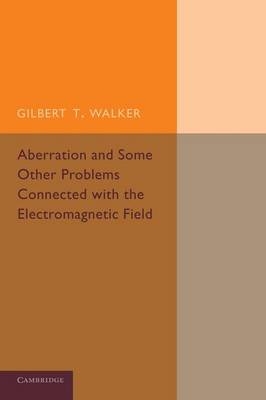
Aberration and Some Other Problems Connected with the Electromagnetic Field
Cambridge University Press (Verlag)
978-1-107-43260-4 (ISBN)
Originally published in 1900, this book contains the text of the Adams Prize-winning essay for 1899, which attempts to construct a theory of the electromagnetic field 'consistent with the modern interpretation of chemical, optical and magnetic phenomena in terms of electrically charged particles'. Walker became an expert on the science of climate and was knighted in 1924, and this early essay is a good example of his early interest in electromagnetism. This book will be of value to anyone with an interest in electromagnetism or the early work of Sir Gilbert Walker.
Preface; Table of vector notation and formulae; Table of notation of physical quantities; Part I: 1. Difference in conceptions of polarisation; 2. Flux in continuous polarisation; 3-4. Analysis of molecular polarisation; 5. Density due to molecular polarisation; 6. The existence of convection currents; 7-9. Flux of molecular polarisation; 10. Effect of motion on permeability; 11-12. Equations of the field when the polarisation is continuous and motion takes place: the electric and magnetic forces at a moving point; 13. The polarisation in a moving medium; 14. Equations of the field when the ether is stationary and material media whose polarisations are molecular drift through it: the polarisation of the ether is assumed to be continuous; 15. The same when the polarisation of the ether is molecular; 16. Comparison of results; 17-18. Boundary conditions; Part II. 19. Extension of the transformation of Lorentz which gives a stationary distribution corresponding to one in which molecularly polarised media drift through stationary ether; 20. Airy's 'water-telescope' experiment; 21-24. Double refraction of light in a drifting medium; 25. Experiments with rotating dielectric plates; 26. Theory of Röntgen's experiment; 27. Theory of Röntgen's experiment; Part III: 28. Stress in the ether when the electric and magnetic polarisations are entirely continuous and the ether and matter have a common velocity; 29. Resultant force per unit volume under the same conditions; 30. Stress in the ether when the polarisations of the ether are continuous, those of the material media are molecular, and the ether has the same velocity as the matter; 31. Preliminary considerations; 32-33. Energy in the field in a special case, and an example of the need of modification; 34. Stress in the ether when it is stationary and molecular polarisation drifts through it; 35. The force per unit volume in this case; 36. The couple per unit volume; 37. The value of the force when the field is stationary and steady; 38. The result of assuming (DE' + GH')/8π as the potential energy; 39. An example of the effect of the motion of a surface upon the force in action upon it; 40-41. Discussion of the case in which there is no drift; 42. Relation between stress in the ether and stress in the material medium; 43-44. Force at a surface of discontinuity; 45. Distinctions between electric and magnetic polarisations; 46. Interpretation of electric polarisation in terms of ions; 47. Interpretation of magnetisation in terms of ions: the two hypotheses in relation to susceptibility; 48. Equations of the field when the second hypothesis is made; 49-51. Stress in the ether under the same conditions; 52. Stress in the material medium in an electrostatic field; 53. Stress in the material medium in a magnetostatic field; 54. Comparison of theoretical stresses with the results of observation; 55. Experimental investigation of stress in an electrostatic field; Part IV: 56. Experimental investigation of stress in a magnetostatic field; 57. Velocity of light when a continuously polarised medium drifts through stationary ether; 58. Determination of the velocity with which the ether must be dragged by a continuously polarised medium, in order that Fresnel's coefficient may be obtained; 59. The direction and velocity of ray-propagation under the above conditions; 60. Reflection and refraction; 61.Röntgen's experiment is inconsistent with the hypothesis of § 58.
| Erscheint lt. Verlag | 2.10.2014 |
|---|---|
| Verlagsort | Cambridge |
| Sprache | englisch |
| Maße | 152 x 229 mm |
| Gewicht | 190 g |
| Themenwelt | Naturwissenschaften ► Physik / Astronomie ► Elektrodynamik |
| Technik ► Elektrotechnik / Energietechnik | |
| ISBN-10 | 1-107-43260-X / 110743260X |
| ISBN-13 | 978-1-107-43260-4 / 9781107432604 |
| Zustand | Neuware |
| Haben Sie eine Frage zum Produkt? |
aus dem Bereich


